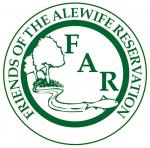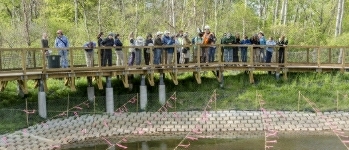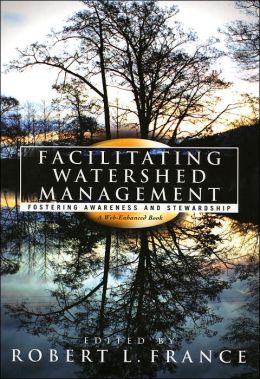Review of Robert France and his books by Ellen Mass
Over a decade ago the state approved a comprehensive plan for restoration of the Alewife Reservation. With the loss of the buffering Silver Maple Forest adjacent to the Alewife Reservation, the 2002 Master Plan needs to be fully implemented to protect it and realize the full potential of Cambridge's last remaining wild lands.
The restoration of the Arthur D. Little parking lot to a wetland meadow, the Storm Water constructed wetland, and the Blair Pond restoration showcase the possibility of returning the reservation's ecology to a high level of functionality. In the Master Plan, Dr. Robert France, then of Harvard's Graduate School of Design, documented the environmental value of the coastal Alewife area. The Reservation is the largest green space in the Mystic River watershed, and the last remnant of the Great Swamp, giving it great historical and ecological significance. The Friends of Alewife Reservation feel strongly that the loss of the Silver Maple Forest makes it imperative that the rest of the design plan now be fully implemented and that the Mugar properties now under the same floodplain threat in Arlington be conserved. Action is required to ensure the long-term ecological viability of this critical wetland resource. The Master Plan calls for improvement of water quality and restoration of the natural hydrology.
Alewife Brook and the Little River drain the Upper Alewife Basin of over 500 acres, encompassing five municipalities flowing for three miles between Cambridge and Arlington to the Mystic River. While there have been expensive remediation efforts ongoing from 2013-2015, the basin was described by France as the "most flood prone and combined sewer ridden river in the eastern part of state." US-EPA confirmed this assessment at its 2015 Science Forum of the Mystic Steering Committee, as one of most impaired water bodies in 76 sq miles of Mystic watershed with many dead animals now appearing on the Reservation core.The Massachusetts Water Resources Agency (MWRA) is currently expanding the sewer interceptor at the entry to the Reservation behind the Alewife T stop to accommodate more development. This part of the watershed requires regional planning, but France decried the state's jurisdiction limitations of "home rule" that supersede regional planning. This lack of watershed level planning endangers low sea level neighborhoods, which with climate change will be increasingly subject to extreme flooding.
France made the case for restoration of water flow "Today, we need to look at Alewife, diseased with polluted water as a form of hemorrhaging." "Hydrology is poor with low flow and re-channeled river and remains this way today." There is no long term beneficial groundwater seeping into the wetlands during the summer droughts to maintain a base flow in Alewife Brook and Little River."
In his books on watershed issues, France warns that, "Whenever a culture loses sight of their water sources and stops acknowledging their importance, long term problems occur." and that, "Polluted rivers, paved-over wetlands, saline farmland, contaminated groundwater and overused aquifers are all caused by our disconnect from water as the source of life."
Another goal of the Master Plan is to improve educational opportunities. Francis delights in the giant Mystic River Watershed Association murals on Mystic Avenue in Somerville that powerfully illustrate the natural history of the watershed, as does the creative 90-ft. biodiversity mural produced by Friends of Alewife Reservation over the Alewife T stop. This was created after the "Biodiversity Days" community event in 2002, sponsored by Friends of Alewife Reservation (FAR), in collaboration with Harvard biologist, E.O. Wilson, and Executive Office of Environmental Affairs Secretary, John Durand, creator of the Commonwealth "Bio-maps." France foresaw the Mystic River Watershed Association's annual Herring Run as another community watershed event with great potential for raising watershed awareness. MyRWA has continually pointed out the very poor testing results of the Alewife sub-watershed and advocate with the federal and state authorities for its improvement as they have done throughout the regional watershed with impressive improvements to the Malden River.
As a prolific author covering hydrology, urban and landscape design, and philosophy, France's books also discuss the role of the arts in forming conservation values. Starting with Thoreau's natural philosophy he shows how spiritual approaches and nature art performance are essential to creating holistic and integrative ways of connecting to our vital water corridors. Calling for conservation measures for Alewife, France counts on inspiring "artistic literati" such as Henry Thoreau, James Joyce, Norman Maclean, Lo Pi, and Annie Dillard. These writers inform us of the intimate experience of "deep immersion" that transcends all boundaries for a restorative life and rebirth experience with nature." France is enamored with the essence of water that he says "defines us" and gives us life-giving properties.
During France's tenure at Harvard, he gave workshops and international conferences on watershed health, urban landscape design, climate protection, and species biodiversity. He spotlighted the Mystic River watershed and especially the Alewife sub-watershed as a challenge for the municipalities and state to take stringent conservation measures for their survival. In his book, "Facilitating Watershed Management," he modeled successful watershed projects from all over the world. In 2004, the Alewife watershed was the focus of two dozen projects for Harvard thesis requirements, professional development classes, and landscape design experiments, as he assumed his role with the state MDC (now Department of Conservation and Recreation) as an Advisor to the Alewife Master Plan. His 700-page handbook of water design modeling expanded the technical aspects of watershed management and is used all around the world.
He dedicates the book "to watershed stewards for effective communication, empowered educational outreach and inspirational projects," knowing that passionate volunteers and caring community members are necessary for protective stewardship. Watershed groups such as FAR are cited for their outreach and ability to mobilize against abuses for watershed protection and for local educational tours. In the international conference book "Handbook of Water Sensitive Ecological Planning and Design," France wrote, "Urban wilds like A.R. are known for connecting city dwellers with nature."
The Alewife Master Plan promotes the protection of wildlife and enhancement of habitat as important goals, but today, only 10 percent of the Master Plan has been completed, and the core woodland silver maple forest buffer (estimated at 700 trees has been removed of over 8 acres for a residential building.
France highlights Vancouver researchers who explain, "We are displacing other species at the peril of our own survival because we cannot survive without biodiversity awareness. Aquatic diversity, has suffered the most." British Columbia, says France, recognizes that sustainability of their economy and communities depend on presence of sustainable environment. "Social Capital", defined by France, is about people and their worth. "Natural capital is the sum total of ecological systems that support life and cannot be produced by humans who erode them." This capital is the foundation on which our "systems" exist, e.g. 80 percent of 1330 species cultivated for food require wild pollinators. "As our green space dwindles and development continues with encroachments on waterways, societies opinions strengthen for preserving the few remaining precious and precarious spaces."
He and students designed a cleansing watershed/wetland garden similar to Cambridge's 2013 storm water wetlands, touted by the state's environmental leaders as a New England highlight, Three marsh levels and tens of thousands of diverse wetland plants clean and filter the water from a dense neighborhood nearby. With 1700 new units under development, and more coming, the storm water wetlands will require careful monitoring to ensure their sustainable operation, which is not presently being conducted A larger example of riverine restoration is China's Cheungdu Park consisting of 50 miles of flood plain park or "living water garden". The park design makes use of flow form shapes symbolizing a fish, and cleans the river water,. The Chinese developed the theme of "keepers of the water", a system of many volunteers who are stewards in community groups providing environmental education for, spiritual connection to the waterways of China.
Similarly, France encourages watershed restoration projects at Alewife. "Restoring or constructing a wetland can be as aesthetic a process as building a garden or atrium." This is a small part of what is needed at Alewife to restore a dense urban watershed that is challenged by the residues of toxic industrial waste, bacterial contamination from sewage overflow, and overbuilding in close proximity to the reservation. The demise of the last Silver Maple Forest in Cambridge of 8 acres is the direct legacy of ex Governor Patrick's shortsighted "government at the speed of business", and at the expense of devastating the environment. His inaction to save this last remnant of critical watershed forest is in exact contradiction to the values demonstrated and espoused by France.
Although Cambridge is mainly characterized as a university and literary center, its Native American and agricultural history including alewife harvesting, are reminders that this vital floodplain is equally noteworthy. "The Reservation was once Native American seasonal fish camps, ice pond cutting and distribution throughout the world, and brick production from Alewife clay deposits."The resulting clay pits still exist now full of contaminated water. In the last century, heavy industry claimed parts of the marsh followed as residential and commercial development in the 1950's. France stated that although" Alewife watershed is one of the historically most fascinating in the country, today it is often studied as the worst example of urban planning."
- Home
- Directions
- FAR Wildlife Blog
- Calendar
- News
- Donate Now
- Get Social!
- Storm Water Wetlands
- Plants and Restoration
- Photos
- Videos
- About & Projects
- Master Plan for Alewife
- Archive
- Newsletters
- Contact
 Presentation Spotlighting Alewife Reservation
Presentation Spotlighting Alewife Reservation
 Follow us on Twitter
Follow us on Twitter
 Like us on Facebook
Like us on Facebook
 Follow us on Instagram
Follow us on Instagram
Forward our web address to a friend!
- An Urban Gem - Alewife Reservation Nature Preserve
- Envisioning The Silver Maple Forest
- History and Policies of Cambridge, Belmont, and DEP
- Storm Water Wetlands
- Friends of Alewife Reservation brochure
(front, back) - Technical Analysis of Upper Alewife Basin
- Watershed: An Excursion in Four Parts
- The River Is A Restless Spirit: Life in the floodplain forest
-
Assessment of Silver Maple forest for DEP Adjudicatory hearings and
Patrick Fairbairn, author of the Assessment - Community Native Garden Flora
The
Alewife Reservation
is a unique natural resource for the communities of Belmont, Arlington and Cambridge
and home to hundreds of species, including hawks, coyotes beavers, snapping turtles, wild turkeys and muskrats,
the reservation is a unique natural resource for the community.
Historical information (Powerpoint)
Friends of Alewife Reservation works to protect and restore this wild area and the surrounding area for the water quality, native plants, animals and over 90 bird species with paths for walking, running and biking, recreation, and for classroom education and research. We regularly steward and preserve the Reservation area for wildlife and for the enjoyment of present and future generations.

(video)
By-Laws
About Friends of Alewife Reservation
Statement of Purpose
Citizen Forester newsletter archive
The Birds of the Cambridge Region of Massachusetts

by William Brewster 1906
Nuttal Ornithological Society
Biodiversity Study of Alewife Reservation Area: Species, Habitat, Ecosystems

Inventories by David Brown, wildlife assessor (2003, 2004.) Published by and available from FAR for $10. Write or call for your copy. (sample)
Updated Dave Brown Inventories (2008, 2010)
Inventories of Alewife Reservation Wetland Plants by Walter Kittredge, Botanist (2013)



